

Download all Lessons. Format Size 28 MB, 741 pages Download Time About 30 minutes for dial-up users, about 3 minutes for broadband users Start Download ↓ At the American Chemical Society, we're always hard at work developing resources to support elementary and middle school science teachers.
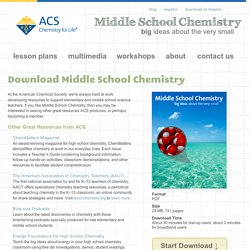
Other Great Resources from ACS ChemMatters Magazine An award-winning magazine for high school chemistry, ChemMatters demystifies chemistry at work in our everyday lives. The American Association of Chemistry Teachers (AACT) The first national association by and for K–12 teachers of chemistry, AACT offers specialized chemistry teaching resources, a periodical about teaching chemisty in the K–12 classroom, an online community for share strategies and more. Physical Science. Lesson at a Glance: Curriculum: Delta Science Modules “States of Matter” Grade: Sixth Topic: Melting Point of Ice During the two weeks prior to the lesson seen in the video, the students had been studying various kinds of energy transfer with their teacher Gina Robertson.

In this lesson, Paula asks the students to put a thermometer in a glass of ice and take a reading. They then remove the thermometer from the ice and place it in a glass of warm water. As the students watch the volume of the red liquid in the thermometer expand, they speculate that it is because it has absorbed “heat energy” from the warm water. Paula comments, “First I wanted to develop the idea that the same amount of matter, which is that red liquid, can somehow occupy two different amounts of space, and why that’s happening.” About Booklets - EAL Science Project. OpenStax CNX. Particlemodels. Particulate Nature of Matter and Changes of State. Gallery of Full-sized, Full Color Art for Licensing<br />SCIENCE CONCEPTS. Free Online Science Games. Kid's Corner - Mammal Page. Christopher Thornton. I've had loads of people asking why I only target C grades in some of my videos, asking if they're relevant to them, and requesting more higher tier content.

This video explains how it all works and why I've organised things in the way I have. Try the Snapquiz: Get the app at:
Plants. If you're not a microbe and you're not an animal, you are probably a plant.
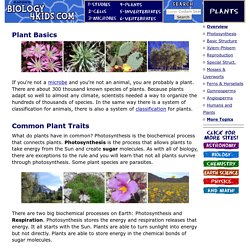
There are about 300 thousand known species of plants. Because plants adapt so well to almost any climate, scientists needed a way to organize the hundreds of thousands of species. In the same way there is a system of classification for animals, there is also a system of classification for plants. What do plants have in common? Photosynthesis is the biochemical process that connects plants. Matter: Evaporation. Sometimes a liquid can be sitting in one place (maybe a puddle) and its molecules will become a gas.
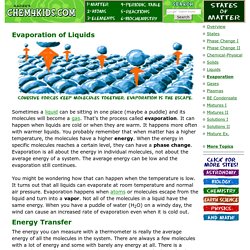
That's the process called evaporation. It can happen when liquids are cold or when they are warm. It happens more often with warmer liquids. You probably remember that when matter has a higher temperature, the molecules have a higher energy. When the energy in specific molecules reaches a certain level, they can have a phase change.
You might be wondering how that can happen when the temperature is low. The energy you can measure with a thermometer is really the average energy of all the molecules in the system. The rate of evaporation can also increase with a decrease in the gas pressure around a liquid. The Evaporative Stress Index (NASA/GSFC Video) > Chemistry Activities and Games Free Downloads. Cool Sound Vibrations - Water Waves on a Speaker. Page 6. 81.04.10: Perception and Sense Organs A Writing Unit for Biology. Students in my biology classes are always interested in sense organs and perception.
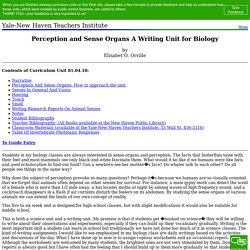
The facts that butterflies taste with their feet and most mammals see only black and white fascinate them. Chemistry Tutorial :Writing Laboratory Reports. Key Concepts The term "Laboratory report" is usually abbreviated to "lab report".
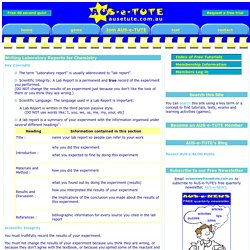
Scientific Integrity: A Lab Report is a permanent and true record of the experiment you performed. (DO NOT change the results of an experiment just because you don't like the look of them or you think they are wrong.) Problem Solving - Word Problems. Khanacademy. Scaffolding for writing & talking science - AST.
On-line calculations Quiz 6. Reacting mass ratio calculations. The Fuse School - Global Education. HowStuffWorks - Learn How Everything Works! The best apps, games, websites, and digital curricula rated for learning. Chemistry help. Chemistry help. Doc Brown's Chemistry Clinic GCSE/IGCSE/A Level Chemistry Revision Notes Quizzes Science Biology Physics e-learning website free resource to use online. Kamal Wafi. It's Okay To Be Smart. The Periodic Table of Videos - University of Nottingham. Chemistry Games. Play chemistry games online!
Home. Common Compound Library A searchable database of over 800 common compound names, formulas, structures, and properties.
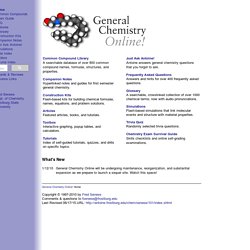
Companion Notes Hyperlinked notes and guides for first semester general chemistry. Construction Kits Flash-based kits for building chemical formulas, names, equations, and problem solutions. Articles Featured articles, books, and tutorials. Toolbox Interactive graphing, popup tables, and calculators. Tutorials Index of self-guided tutorials, quizzes, and drills on specific topics. ScienceNews for Students. MinutePhysics.
What is it? « Algodoo. Algodoo is a unique 2D-simulation software from Algoryx Simulation AB.
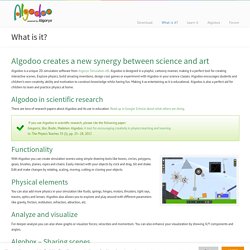
Algodoo is designed in a playful, cartoony manner, making it a perfect tool for creating interactive scenes. Explore physics, build amazing inventions, design cool games or experiment with Algodoo in your science classes. Algodoo encourages students and children’s own creativity, ability and motivation to construct knowledge while having fun. Making it as entertaining as it is educational.
Mosaicscience.com. J C Science Quizzes Home Page. Gravity Weights For Everyone (Slug Life Part I) Science Out Loud — MIT+K12 Videos. SOL is a YouTube webseries hosted and co-written by MIT students on everything from the physics of skydiving to the biochemistry of farts.

With episodes no longer than 5 minutes, these videos take the traditional concepts taught in middle and high school science, engineering, and math (STEM) classes and puts them in a context completely outside the classroom. You won’t find a single equation in these videos - instead, they feature the gamut of hosts and personalities who will take you into labs, rivers, and the sky!
Creates (1) 5-min. episodeCook time: ~150 man hours Directions. Tyler DeWitt. Balancing Chemical Equations - Reactants, Products, Chemical Reactions. Beginner's Guide - Balancing Equations. Bozemanscience.